| RTI Filed On Tantrum Thowing Diva Of Hockey India |
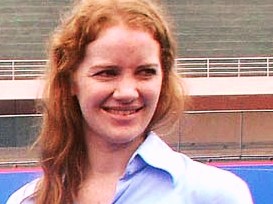
RTI Filed on Hockey India Official For Abusing Indian Hockey Captain
 ight to Information
no. MOYAS/R/2018/50534 has been filed with Ministry of Youth Affairs and
Sports, Government of India, asking for the following 10 pieces of information: ight to Information
no. MOYAS/R/2018/50534 has been filed with Ministry of Youth Affairs and
Sports, Government of India, asking for the following 10 pieces of information:
- When and where was the post of the Hockey India CEO advertised?
- For how many weeks was the job posting kept open for candidates to apply?
- How many candidates applied? Did Indian citizens get a chance to apply?
- What were the experience requirements of Hockey India CEO, at the time of the job posting?
- Was Ms. Elena Norman the best candidate that met all the experience requirements?
- Does Hockey India believe that if you do some Event Management, you can become its CEO?
- Are the CEO experience requirements so specialised that no Indian was found suitable?
- Is this post of an indefinite tenure. If not, what is the term of the CEO post as advertised?
- Is the CEO's salary being paid, directly or indirectly, by Ministry of Youth Affairs & Sports?
- On the night of 11th December, 2018, in the VIP Lounge of the
Kalinga Stadium in Bhubanesvar, on the occasion of the Odisha Men's
World Cup, Hockey India CEO was heard giving abuses and curse words
to Indian hockey captain Manpreet Singh plus 3 other national team
players and an official working for event hospitality. Is this
acceptable behaviour of a Hockey India official. If not, is this
sufficient grounds for dismissal from her post of Hockey India CEO?
Background Information: The world over, sports
federations select their CEOs in a professional and transparent process.
As an example, when Hockey Australia was looking for a CEO, the job
posting was publicly listed on the Hockey Australia website, along with
information on how to apply for the position, and the job duties were
clearly stated. The eventual candidate they selected had the following credentials:
- Educational Background: Bachelor in Physical Education, MBA
- Federation Experience: Athletics Australia, Soccer Australia
- Academy Experience: Western Sydney Academy of Sport, Queensland Academy of Sport
- International Experience: UK Athletics, UK Sport
- Most Recent Role: Director of Australian Institute of Sport.
Given the rigorous and transparent selection procedure of a national
hockey federation as shown above, did Hockey India followed due process in appointing its CEO?
|
| Sports City Bhubanesvar - Ideal Venue for the World Cup |
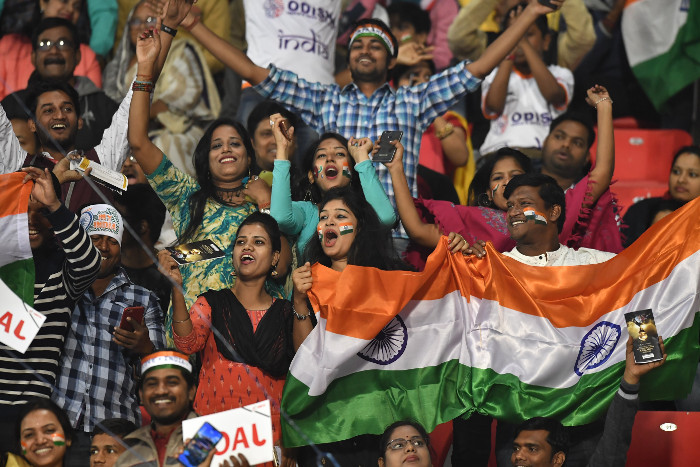
Article compiled from reports in
Hindu and
FirstPost,
Photograph courtesy FIH
 unique
feature of the 2018 Men's Hockey World Cup was that the
government of Odisha and the entire city of Bhubanesvar was involved in
the event. Hockey-themed murals were painted across the city's walls;
cultural festivities and artisans' exhibitions were organised in the
city; the opening ceremony was lavish in its scale and city schools were
wholeheartedly involved with the event. unique
feature of the 2018 Men's Hockey World Cup was that the
government of Odisha and the entire city of Bhubanesvar was involved in
the event. Hockey-themed murals were painted across the city's walls;
cultural festivities and artisans' exhibitions were organised in the
city; the opening ceremony was lavish in its scale and city schools were
wholeheartedly involved with the event.
FIH Master Coach Siegfried Aikman, who coached Japan to the hockey
gold at the 2018 Asian Games, said: "When I stepped out of the plane in
Bhubaneswar Airport, I was smiling nonstop. This was because everything
in the airport was about hockey and the World Cup. At the Kalinga
Stadium, even when India is not playing, there are so many people. They
cheer for everyone. This doesn't happen in any other stadium in India.
The dressing room and facilities are superb."
The government of Odisha invited the ambassadors of the 15
participating countries (the sixteenth being India), as well as India's
ambassadors in the participating countries. In attendance over the
opening five days were the ambassadors of Argentina and Belgium, the
French consul general in Kolkata, and diplomats from China, Great
Britain, Ireland and Argentina, many of them with their spouses.
Netherlands ambassador Marten van den Berg, a keen sports follower
who attended the final said, "The audience, the officials,
the organisation for the World Cup - everything was +++. The players also
have a very good feeling about the tournament."
The citizens of Bhubanesvar were in a zone of abundant choices.
There was the Bhubanesvar Fest at the exhibition ground, with
storytelling, food and entertainment. A Fan Village had been set up at
Kalinga Stadium, with large viewing screens, activities for children,
World Cup merchandise and eateries.
The stadium was near-full for the afternoon games and full for the
late evening games. Despite these numbers, security was friendly and
unobtrusive. There was not a single incident in the field or on the
stands requiring a security scramble.
Spectators embraced good play all around, and also encouraged injured
players for their effort that was above and beyond. They remained seated
right until the end of the shootout in the semi finals, and until the
end of the medal ceremony after the finals. Such impeccable manners show
the innate grace of Bhubaneswar's fans, and a proper understanding of
the magnitude of the occasion.
Former India captain, three time Olympian and a member of the Indian team that
won the hockey gold at the Moscow Olympics, M. M. Somayya was thrilled to
watch all the action at the World Cup at the Kalinga Stadium.
Impressed by what he has seen, Somaya said: "I was a player in the 1982 Bombay and 1986 London World Cups. As a
journalist, I covered the 1990 Lahore and the 2002 Kuala Lumpur World Cups.
But I have never seen a World Cup managed and
conducted like the one in Bhubanesvar."
Somayya was particularly pleased with the way the game and players were
portrayed. "Not only the streets everywhere are full of hoardings, but
also the venues. The roads talk only about hockey here. The players have
been made heroes. The arrangements for players and spectators in the
stadium is remarkable. There is also a fan park where spectators can
mingle with the players and their idols. The crowd is very participative
even when India is not playing. It's a huge celebration of hockey. Bhubanesvar
is one of the best centres in world hockey today."
The government arranged tours of Bhubanesvar, Konark and Puri for
diplomats and FIH officials. Suresh Nair, Air Asia's General Manager for
South Asia, launched a new flight from Bhubaneswar to Bangkok. Players
and officials from various teams went to the beaches of Puri.
By promoting complementary activities around the World Cup during the
busy season, the World Cup became the trial ground for a sports
tourism policy in India. By means of its advertising campaign 'Odisha by Day, Hockey by Night',
and by branding the temple city of Bhubanesvar as the spiritual
home of Indian hockey, the Government of Odisha made the 2018 Men's
Hockey World Cup a memorable events for players, fans and tourists alike.
|
| The Rich Nations Of Hockey And Poor Nations Of Hockey |
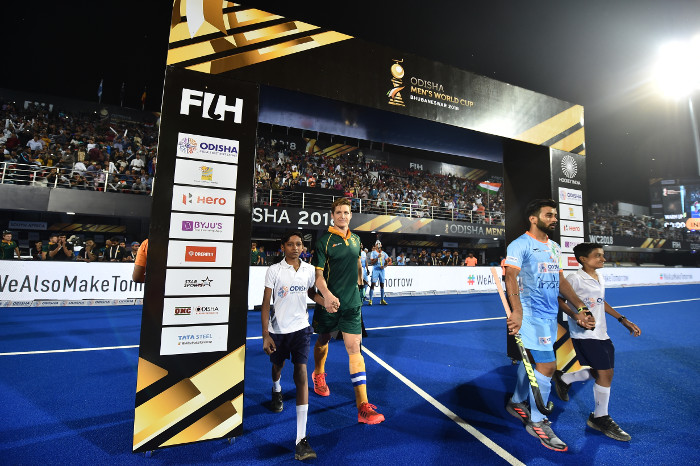
Rich Hockey Nation (India) vs. Poor Hockey Nation
(South Africa)
Article by Hockey Insider, courtesy
FirstPost.
Photograph credit FIH
 he
Odisha Men's Hockey World Cup showcases the lopsided world of hockey,
where full-time professionals with millions at stake compete with teams
comprising motley groups of artisans, teachers, students and day-wagers. he
Odisha Men's Hockey World Cup showcases the lopsided world of hockey,
where full-time professionals with millions at stake compete with teams
comprising motley groups of artisans, teachers, students and day-wagers.
It is a rich man's game in Europe, an amateur sport in Oceania, Americas and
Africa and a poor-man's sport in Asia.
EUROPE
Netherlands: Dutch professional contracts are the most
attractive ones in hockey, chased by players across the world. All the
leading Dutch players have contracts from top local clubs, which also
attract several foreigners.
Germany: After the Dutch come the German clubs for the exposure they provide to top-grade hockey
players. Many of the students pursuing professional degrees are also
eager followers of hockey, despite it being a minor sport in the overall
scenario in the country. For a student, joining a German club also ensures a smooth
passage in admissions to leading universities and scholarships.
Belgium: After the Dutch and Germans, Belgian clubs
have added a new dimension. Also, several leading Belgian players play
across the border for Dutch clubs.
England: Since lottery money began funding sports in England, their players now have
annual contracts. Some players also pursue additional academic and
professional qualifications. It is to be noted that the last two
successes for English men's hockey (1986 World Cup silver, 1988 Olympic
gold) came when players were primarily amateur, and having to look for
off-season work.
Spain: The economic meltdown in the
country left Spanish hockey in a precarious situation, where finding
funding for the national team has became tough. The game is mainly
amateur in Spain, with most players coming from the hockey hubs of
Terrasa and Barcelona, with a few from Madrid completing the squad. Top
Spanish players get attractive offers and play abroad for other European clubs.
Ireland: In 2017, Irish players had to pay
from their pockets to make the trip to the Hockey World League
Semi-finals, from which they earned qualification for the 2018 World
Cup. Out of the core group of 20, there are 15 guys playing outside
Ireland, for clubs in Belgium, Netherlands, Germany and England . Says
Irish goalkeeper David Harte, "Many of us are working or studying. Some
are accountants, some are lawyers and some are students. I am doing my
Master's, my brother (Conor) is studying for his Ph. D."
France: Close to two-thirds of the French national team members play abroad, mainly in
next door Belgium, which has a robust hockey structure. The
French team is made up of students, a vintner, an aspiring music
producer, a marketing manager, a doctor, a lawyer and IT professionals.
OCEANIA
Australia: Australian hockey now gets funding from the
government based on their international performances. In addition,
players have the option of playing for top clubs in Europe and
elsewhere.
New Zealand: The sport of hockey in New
Zealand is mostly amateur. Players have to chase their own careers by
playing for clubs abroad, like current captain Blair Tarrant who plays
in Germany.
AMERICAS
Argentina: The Argentine squad comprises an equal mixture of domestic club players
and others who ply their trade for overseas clubs.
Canada: Hockey clubs in Canada mainly exist on the eastern and western side of
the prairie provinces. South Asian immigrants, mainly from Goa and
Punjab, with their traditional links to the sport make up some of the
squad. Canadian players occasionally have to dig into their pockets to
be able to appear in FIH tournaments.
AFRICA
South Africa: Devoid of support from both the National
Olympic Committee and the government, South Africa's hockey continues to
pull along. Despite being the top team in the African continent, they
were prevented by their own National Olympic Committee from
participating in the 2016 Rio Olympic Games. For the 2018 World Cup,
the South African players had to contribute 60,000 Rands
of their personal money to the fund for sending the team to Bhubanesvar.
ASIA
China: The entire Chinese squad comes from just one of China's
34
provinces - Inner Mongolia Autonomous Region. The players have modest financial support. China
even withdrew their team for the 2018 Asian Games in Jakarta at the
eleventh hour.
Malaysia: The federation has a sustained funding
programme through the National Sports Council. In addition, players get
wages from their respective employers and have club contracts. Hockey
players come from modest backgrounds and look for full-time employment
through hockey for financial security.
Pakistan: Players have to make frequent complaints
just to get their allowances. Corporates are not lining up to sign
sponsorship contracts with the Pakistani team, which is a far cry from
the past decades when hockey gave the nation its proudest sporting
moments. Pakistan's participation in the 2018 World Cup was in serious
doubt over lack of funds, and only a last-minute intervention by a home
appliance company who pumped in Rs. 90 lakh made the trip
possible.
India: Full-time employment is offered to most hockey
players in the Indian squad, or even those on the periphery of it.
Players can continue to attend the national camps almost round the clock
and still receive the monthly salaries from their respective employers.
The Indian players appear to be hockey professionals in the truest form
- no Indian national team player has to withdraw money from his savings
account, or ask his parent to contribute to buy the ticket to play in
the elite FIH events.
|
| B. G. Joshi - Master Hockey Statistician Of The World |

Article by Mufeed Mahdi Rizvi, courtesy Mumbai Mirror
 he
year was 1968. Defending champions India, with seven Olympic hockey gold
medals were hot favourites for their eighth title. At 7.30 pm IST, a boy
joined the huddle of Indian supporters gathered around a transistor
radio at Bulbul Mian's tea stall. he
year was 1968. Defending champions India, with seven Olympic hockey gold
medals were hot favourites for their eighth title. At 7.30 pm IST, a boy
joined the huddle of Indian supporters gathered around a transistor
radio at Bulbul Mian's tea stall.
Fourteen-year-old Baboolal Goverdhan Joshi's tryst with hockey
started on a sour note, with India's 1-2 defeat to New Zealand. But he
continued to back the team till they reached the third step of the
podium in the 1968 Olympics.
Joshi grew up in an era where hockey, and to some extent football,
were the only two major sports played in rurual areas of India.
"I grew up in a village in Rajgarh district of Madhya Pradesh. We
used to play dadee, a game played with a ball made from cloth
rags and tree branches. Almost every house in the village had cows. So
in the mornings we'd take the cows and hand them over to the shepherd
for grazing. We'd play dadee till the shepherd arrived
to take the cows. Evenings were the same - till the shepherd brought the
cows back to the designated place we'd play this game," Joshi recalls.
Joshi was, however, unaware that the game he was playing was hockey.
Joshi's interest in the game grew with every passing year. Still without
a transistor radio, he'd find places that had one and listen to the commentary
whenever India played.
He then left his village to enroll in the Ujjain Engineering College.
From the 1970 Bangkok Asiad he had started collecting small details, not
with the intention of becoming a statistician, but out of interest.
Then the era of World Cups started. In 1971, India finished third in
Barcelona. In the 1973 Netherlands edition, India returned home with a
silver.
Then came 1975. Every day in his hostel room, around 20-25 of his
friends -- including the owners of the transistor radio - Ratib (UAE) and
Mahmood (Kuwait) - put their ears together for that commentary. India
were progressing well.
"The semi-final against Malaysia was the most interesting one. Poon
Fook Loke took the hosts ahead. Shivaji Pawar equalised. Malaysia once
again took lead through Shanmuganathan before Aslam Sher Khan converted
a penalty corner. And finally, when Harcharan Singh scored the winner,
we were all jumping with joy, dancing around the campus," says Joshi.
After completing his engineering, Joshi landed a job with Madhya
Pradesh's Water Resources Department as an assistant engineer.
It was only after he started earning that he took data collection
very seriously. "FIH used to bring out a monthly magazine called World
Hockey. Subscription to the magazine was £10. Although my salary was not
even £10 in those days, I still subscribed to it," Joshi says, with a smile
and a tinge of pride.
The source of daily match reports was The Hindu. "It was the only
publication that reported every international match played around the world. But I
didn't get the paper at the place I was posted. I contacted the vendor
in Bhopal and gave him an advance. I told him to keep the newspaper with
him. And whenever I got time, I travelled to Bhopal and got the entire
lot. I would then note down every match's details and tally it with the
World Hockey magazine," he says.
Then came divine help. "Looking at my passion, a lady secretary in the
FIH sent me all back-dated issues when I requested her."
During the 1978 World Cup, his first statistical and analytical piece
appeared in Nai Duniya (Indore), one of the biggest Hindi
newspapers in those days. Suresh Gawde, its editor, would carefully edit
his piece and also pay him around ₹25 or ₹30. "Good enough in those
days," says Joshi.
Joshi's stats started appearing with Thyagarajan's articles in The
Hindu and The Sportstar after he met the veteran hockey journalist
during an India-Pakistan match at Gwalior.
Collecting information wasn't easy. From 1984 onwards, Joshi would
take leave from office and attend every Olympic camp held in the
country. Carrying a list, he asked every player the number of matches he
had played and the number of goals he had scored.
Joshi stumbled upon a goldmine on his trip to Lahore for the 1990
World Cup. Every participating team had brought out brochures which
mentioned caps, goals and head-to-head records with other teams. "Once I
got these, I updated my statistics and have been religiously maintaining them
till date," says Joshi.
In Lahore, BBC Sports Correspondent Chris Moore opened up insights on detailing.
Based on his inputs, Joshi set in order the most goals, most caps and other interesting stats.
According to Joshi, FIH has accurate data since 2013, but prior to that, they are unsure. An FIH source
agreed to this. "Some statistical data has gone missing while shifting
office recently. But we are looking to put it in order at the earliest,"
the source told Mirror.
Entries to all records in the early days were made by hand. From
2006, his sons Neeraj and Shravan helped him feed data into his laptop.
"I am from an older generation. I took a long time to make the entries.
My sons reduced my time by helping me. After they left for other cities
for jobs, my niece Megha Chore took over the data-entry role."
Joshi has attended all FIH-conducted tournaments across India. But he
has one question now. "I wonder who will
take this forward. I want to hand this over to someone who is not only
passionate about hockey, but also about numbers."
|
| Aligarh Muslim University To Field First Ever Women's Hockey Team |
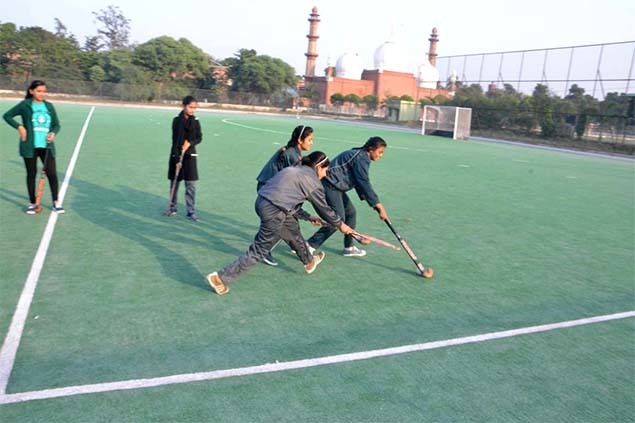
Article by Ishita Misra, courtesy Times of India
 n this
Hockey World Cup season, a glass ceiling looks all set to be
shattered at the Aligarh Muslim University (AMU). For the first time since it
came up in 1920, AMU will boast of a girls' hockey team. n this
Hockey World Cup season, a glass ceiling looks all set to be
shattered at the Aligarh Muslim University (AMU). For the first time since it
came up in 1920, AMU will boast of a girls' hockey team.
As part of a groundbreaking project to open doors for Muslim girls to
take up the national sport, AMU has created its first ever junior girls
team, from students comprising the 10 schools on campus that are
administered by the AMU governing body. If all goes well, AMU girls
could play their first match in an inter-school competition in February 2019.
Preparations are on, and hockey fever has become contagious. It's a
common sight in the evenings to see a group of girls practising at the
university's ground near Sir Syed Hall. They are being coached by
Anees-ur-Rehman, a former Indian international hockey player from the
mid-1980s and current deputy director of the AMU sports committee.
There is also a 'cool vibe' that comes with playing hockey, giving
the girls an edge socially on campus among their peers. "Playing hockey
was never on my mind until one day my brother told me that a girls'
hockey team was being formed. I decided to try it out and now am
enjoying it very much," said 13-year-old Naseem Zehra. "But you know
what's the best part? Everyone now wants to be friends with me since
they think that girls in the hockey team are cool."
Seeing the enthusiasm of their juniors, some college-going seniors
have also taken up the game. Afreen Ali, a final year graduation
student, said she recently took special permission from her hostel
warden to play hockey after class.
AMU has boasted of many illustrious male hockey players through the
decades, with former 1980s captain, Aligarh-born Zafar Iqbal, being the
last Olympic gold medal winner (Moscow, 1980) from the university.
Other Olympic medallists include Masood Minhas (Los Angeles, 1932,
gold), Ahsan Mohammad Khan (Berlin, 1936, gold), Lateef-ur-Rehman and
Akhtar Husain Hayat (both London, 1948, gold), Joginder Singh (Rome,
1960, silver), Joginder Singh and Syed Ali (both Tokyo, 1964, gold),
Inam-ur-Rehman (Mexico City, 1968, bronze), as well as 1975 World Cup
winner B. P. Govinda.
"This is a great beginning for women's hockey and, in particular, for
Muslim girls to get a chance to play the game. It will open many doors
for them," said Aslam Sher Khan, Govinda's World Cup-winning teammate in
1975. Aslam had a brief, fleeting sojourn with AMU, having represented
the university in a North Zone championships in 1970, before going back
to Bhopal.
"You'd be hard-pressed to name a handful of Muslim hockey players at
the top level," he said, adding that Saba Anjum Karim, the 2002
Commonwealth Games gold medal winner from Chhattisgarh, is probably the
most recent Muslim woman hockey player at the national level.
But AMU's mini hockey revolution hasn't come easy. In 1982, Razia
Rizvi, deputy director, physical education at AMU's women's college,
tried hard to make girls play hockey in the university but ran into a
stone wall.
Razia remembers her struggle. "After eight years of effort, when
nothing happened, I dropped the idea," she said, listing acute funds
crunch, and minimal support from university authorities who were
uncomfortable with the idea of women playing what they considered a
'man's sport' as the main reasons for the initial failure.
"However, things began to change a few years ago after Lt. Gen.
Zameeruddin Shah took over. The present Vice Chancellor, Tariq Mansoor,
also supports girls who want to take up sports seriously," she added.
Things have begun to look up. "Initially, we were not sure how girls
would respond to the idea of playing hockey, but we received an
overwhelming response. All the girls have been diligently practising and
working hard. It's an absolute delight to see the girls shaping up well.
This is just the start," says coach Rehman before he went back to the
middle to teach his stick-wielding stalwarts a few more tricks.
|
| Photograph of the Month |

Photograph courtesy FIH
 he
Photograph of the Month for January 2019 is dedicated to the Indian hockey
fans, who have not seen Indian men's hockey win the Olympics or World Cup
for the last 38 years. he
Photograph of the Month for January 2019 is dedicated to the Indian hockey
fans, who have not seen Indian men's hockey win the Olympics or World Cup
for the last 38 years.
Year 2018 was an exercise in futility. In the Azlan Shah Cup held in
Ipoh in March, India finished second last in the tournament. In the
Commonwealth Games held in April, the second-highest ranked team in the
tournament, India, finished without a medal.
In the Asian Games held in August/September, the highest ranked team
in the tournament, India, finished 3rd and thereby lost an automatic
qualification to the 2020 Tokyo Olympics. The Asian Games was won by
world no. 16 Japan.
In the World Cup held in November/December in front of a passionate
crowd in Bhubanesvar, India lost in the quarter-final stage, unable to
end a 43-year-old jinx of never being able to qualify for the World Cup
semi-finals.
The Photograph of the Month is dedicated to the Indian hockey fan
whose heart beats for India, but which is never reciprocated by the
Indian hockey team as they continue to fail at the world level.
|
| Money Matters |
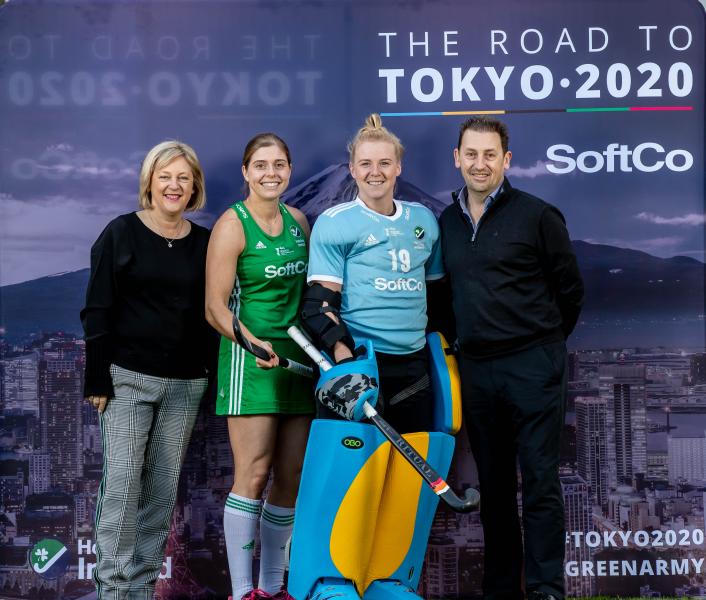
 oftCo,
the leading global Finance Automation Software provider, today announced
the extension of its main sponsorship agreement for the Ireland Women's
Hockey team that will include the 2019 European Championships and the team's
qualification campaign to the 2020 Tokyo Olympics. oftCo,
the leading global Finance Automation Software provider, today announced
the extension of its main sponsorship agreement for the Ireland Women's
Hockey team that will include the 2019 European Championships and the team's
qualification campaign to the 2020 Tokyo Olympics.
Susan Spence, co-founder, SoftCo
said: "We were so proud of the team in their run to the World Cup final
during the summer. An Irish team achieving success on the world stage
was a true inspiration to us all. This is a further significant
investment to assist the team to reach its ambitious goals. We are
delighted to be extending our support."
Ireland Hockey will be getting a new training centre at
Abbotstown, and a new FIH-certified artificial turf pitch at University College Dublin.
SoftCo, who are involved with grassroots hockey for 15 years,
sponsored the Green Army during the 2018 Women's World Cup in
London, where the 15th-ranked team defied the odds to become the first Irish Senior
team to reach the final of a World Cup, in any field sport.
These achievements were recognized at the RTE Sports Awards where the Irish
women's hockey squad won the 2018 Team of the Year and coach Graham Shaw
won the 2018 Coach of the Year.
Forward Anna O'Flanagan said, "After the World Cup, we all went our separate ways,
back to our jobs, back to studies. It's been an incredible year for our
sport. Hockey is back on the map in Ireland. We want to create a legacy
and be role models, not only for girls in sport, but girls in general."
|
| Media Matters |
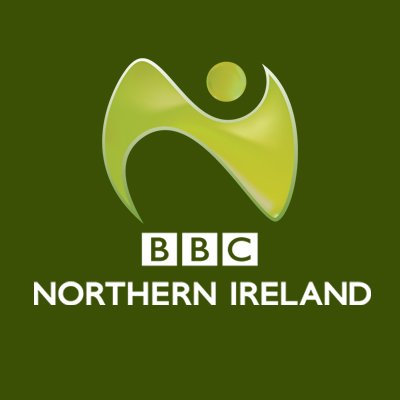
 BBC
Northern Island documentary on the inspirational Irish women's hockey
team will be shown over the Christmas holidays. Entitled 'Live like
Legends', it is a 30-minute programme, produced by Nigel Ringland, to be
broadcast on BBC 2 at 7 pm GMT on Thursday, December 27. BBC
Northern Island documentary on the inspirational Irish women's hockey
team will be shown over the Christmas holidays. Entitled 'Live like
Legends', it is a 30-minute programme, produced by Nigel Ringland, to be
broadcast on BBC 2 at 7 pm GMT on Thursday, December 27.
The documentary, which has highlights from all of Ireland's games,
includes previously unseen footage and will feature coach Graham Shaw,
manager Arlene Boyles and the 19-strong World Cup silver medal-winning squad.
The Irish side made headline news by upsetting the odds with dramatic
penalty shootout victories over India in the quarter-finals and Spain
in the semi-finals, before eventually falling to Netherlands in the final.
The programme will be repeated on BBC Two Northern Ireland on Sunday, 30 December at 10 pm GMT.
|
| Visitor of the Month |
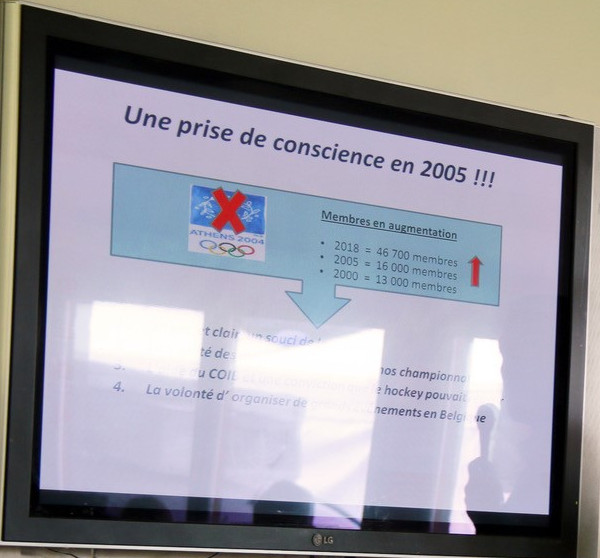
Growth of Hockey in Belgium
 he
January 2019 Visitor of the Month is from
Paris. Like everyone, he is also fascinated with the Belgium success
story. He sent the above image and the following email to BharatiyaHockey.org: he
January 2019 Visitor of the Month is from
Paris. Like everyone, he is also fascinated with the Belgium success
story. He sent the above image and the following email to BharatiyaHockey.org:
Belgium played the first game of the World Cup (against Canada) and
the last game of the World Cup (against Netherlands). This June I
met with officials of the Belgium Hockey Federation. In 2004, they
failed to qualify for the Athens Olympics. They did a conscience
review in 2005, along with a membership augmentation - from 13,000
registered hockey players in 2000 to 46,700 players in 2018. The
World Cup had an amazing, heart-stopping final all the way through
the shootout. Belgium are deserving winners.
|
| Fun With Numbers |

Statistics by B. G. Joshi
 he
January 2019 edition of Fun with Numbers is a statistical survey of Indian men's hockey,
from 1926 - 2018. he
January 2019 edition of Fun with Numbers is a statistical survey of Indian men's hockey,
from 1926 - 2018.
World Ranking: 5
First Tournament: 1928 Amsterdam Olympics (gold)
Last Tournament: 2018 Bhubanesvar World Cup (6th)
| Category |
Description |
MP |
W |
L |
D |
| Matches Win-Loss |
Total Matches from 1926 - 2018 |
1700 |
936 |
490 |
274 |
| Series Win-Loss |
Total 143 series vs. 30 countries |
143 |
91 |
33 |
19 |
| Arch Rival Win-Loss |
Maximum Matches vs. Pakistan |
175 |
62 |
82 |
31 |
| Category |
Description |
TP |
G |
S |
B |
| IOC/FIH Tournaments |
Olympics |
20 |
8 |
1 |
2 |
| |
World Cup |
14 |
1 |
1 |
1 |
| |
Champions Trophy |
16 |
- |
2 |
1 |
| |
Hockey World League Finals |
3 |
0 |
0 |
2 |
| |
Hockey World League Semi-finals |
3 |
0 |
0 |
0 |
| |
Hockey World League Round 2 (pre-semi-finals) |
1 |
1 |
0 |
0 |
| |
Olympic Qualifier |
5 |
1 |
3 |
0 |
| |
World Cup Qualifier |
3 |
0 |
0 |
2 |
| |
Champions Challenge |
4 |
1 |
1 |
2 |
| |
IOC/FIH Total |
69 |
12 |
8 |
10 |
| Continental Tournaments |
Asian Games |
16 |
3 |
9 |
3 |
| |
Asia Cup |
10 |
3 |
5 |
1 |
| |
Asian Champions Trophy |
5 |
3 |
1 |
0 |
| |
Commonwealth Games |
5 |
0 |
2 |
0 |
| |
Afro-Asian Games |
1 |
1 |
0 |
0 |
| |
South Asian Games |
4 |
1 |
3 |
0 |
| |
Continental Total |
41 |
11 |
20 |
4 |
| Invitational Tournaments |
Invitational Tournaments in Asia |
48 |
17 |
7 |
13 |
| |
Invitational Tournaments in Europe |
39 |
10 |
5 |
11 |
| |
Invitational Tournaments in Oceania |
22 |
2 |
9 |
3 |
| |
Invitational Tournaments in America |
2 |
0 |
1 |
1 |
| |
Invitational Tournaments in Africa |
1 |
1 |
0 |
0 |
| |
Invitational Total |
112 |
30 |
22 |
28 |
| |
GRAND TOTAL |
222 |
53 |
50 |
42 |
|
![]()